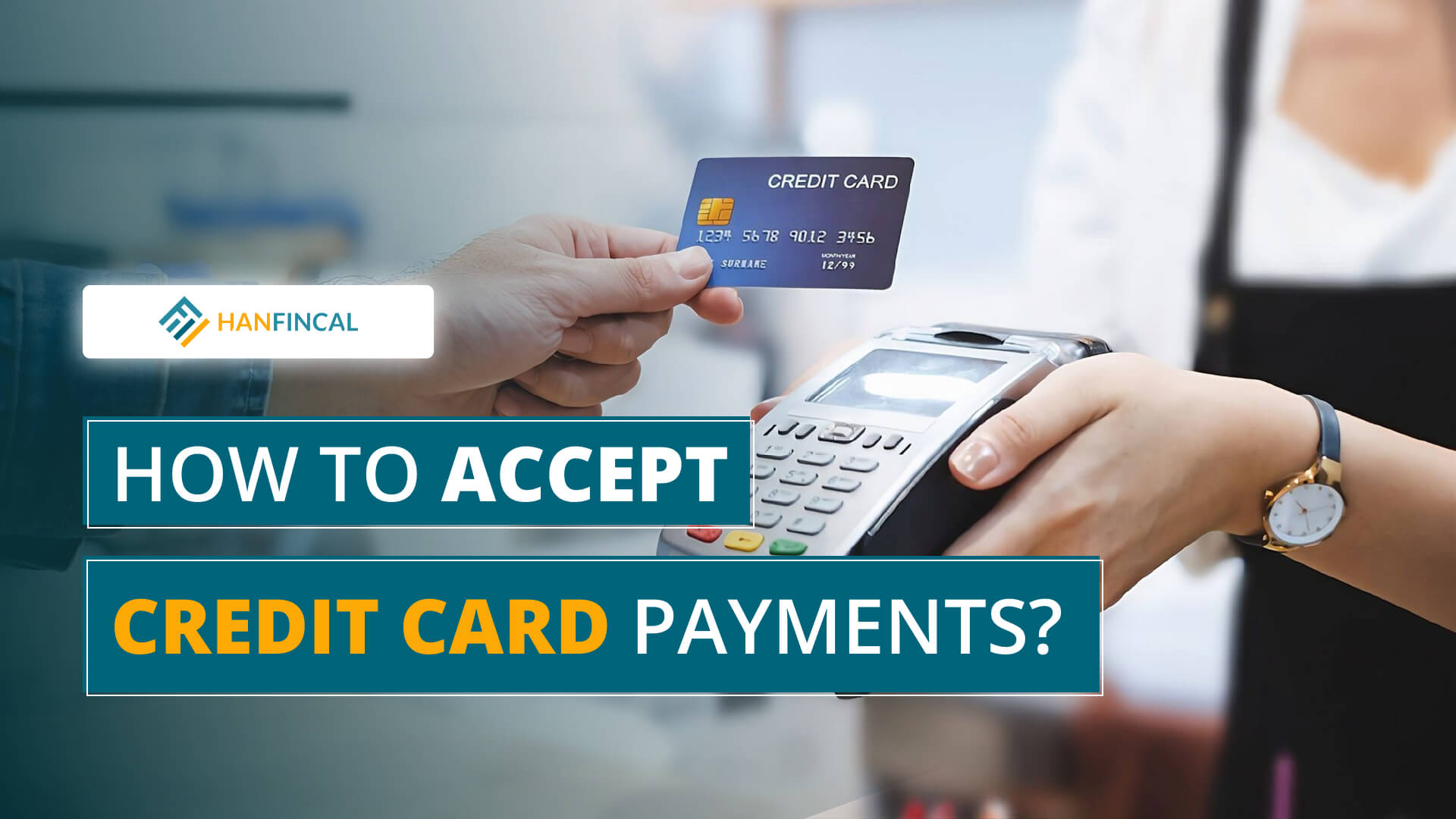How to accept credit card payments is a major concern for many people, especially small businesses. This is because consumers use non-cash payment methods for 74% of transactions in this digital life, research from the Diary of Consumer Payment Choice. Today, Hanfincal breaks down that process so you can understand this field in this article. Let’s get started to learn more. Here’s our guide.
1. How to accept credit card payments for small business?
1.1. Decide how you will accept credit card payments
First, you should consider how much of your credit card transactions will be handled in person, online, and over the phone. You can also think about the types of credit cards you will accept such as Mastercard, Visa, American Express, Discover, and so on.
There are no rules for selecting a payment method. This is relatively dependent on your business model and scale, as long as it meets your needs and is convenient for you. For example, if you open a small brick-and-mortar retail store, you may process payments in person at checkout or install a card reader that’s EMV chip-enabled at checkout. An eCommerce store, on the other hand, only requires payments made online or over the phone.

How to accept credit card payments?
1.2. Choose a payment processing system
To accept credit card payments, you can do it in two different ways: through merchant accounts or payment service providers.
- Merchant accounts: A merchant account is a bank account that holds your money after the credit card network has processed a transaction. Following that, the funds are deposited into your business bank account. However, when we compare it to a payment service provider, the approval and setup process may take longer.
- Payment service providers: Some payment service providers like PayPal, Square, and Stripe enable you to process payments without setting up a merchant account. It is easy to sign up and manage your account online compared to merchant accounts.
Choosing a payment processing system is more likely the most challenging aspect you should focus on. If you have recently run your small business, payment service platform providers may be worth considering, given the lower processing and transaction costs. On the flip side, if you make a lot of credit card sales, a merchant account may be a better way to manage your payments.
1.3. Get your payment hardware and software
This step comes after selecting a proper payment process. You should consider software and hardware that allows you to swipe cards to save time over manually entering every transaction.
- Software:
- Suppose you’re processing payments that need to interface directly with constituent management software, such as donations or membership fees. In that case, many mid-tier and advanced software packages allow you to do so.
- This convenient option enables organizations to process a big volume of a single type of payment while avoiding time-consuming double-entry. Furthermore, while this solution may be applicable in-person, it is best suited for over-the-phone transactions.
- If a payment provider provides POS (point-of-sale) software, it may include inventory onboarding in higher-tiered plans or at an additional setup cost.
- Hardware: These devices can be purchased to connect to a laptop or personal computer via USB and most mobile devices. They range in size from a simple, small card reader to something that can hold your mobile device, which can often extend battery life.
Use only approved, well-known software and hardware. There are numerous payment processors available today, but make sure to check the company’s credentials you choose to work with. Don’t forget to find out training resources from your payment processor to learn how to make the most of your hardware and software.
2. Credit card acceptance in person, online, and over the phone
2.1. How to accept credit card payments over the phone?
Many businesses, from restaurants to retailers, receive phone orders. It is generally regarded as an added service to boost customer satisfaction in an increasingly card-centric society. This process involves customers giving the merchant their credit card number, and the merchant manually enters that information into their card reader.
To accept credit card payments over the phone, you’ll need a credit card reader as well as a POS or an online payments gateway. These payments are more expensive than getting physical cards with a credit card reader because of the higher risk of accepting payment. Most processors charge 2% to 4% of the transaction amount.
2.2. How to accept credit card payments in person?
To accept credit card payments in person, you will need:
- A point-of-sale (POS) system: This software with a card reader or a card terminal capable of processing transactions on its own is required.
- Card reader: It may come with a POS system. If not, you may need to purchase one and expensive installations can cost more than $1,000.
- Payment processor: This is the service that initiates and completes transactions with card networks (such as Visa or Mastercard). Payment processor often charges a transaction fee for each payment accepted. Most processors require a contract for a set period, usually one or two years. Early termination or cancellation fees are frequently included in contracts.
With in-store payment, customers present their cards to purchase these transactions. Given the presence of the cardholder and card for these types of transactions, the risk of fraud is lower, so in-person transactions typically have lower fees than other transactions.
2.3. How to accept credit card payments online?
Credit card payments online can help a fairly seamless shopping experience, save excessive time, and this is a popular method these days. Without the capacity to accept these payments online, eCommerce stores, restaurants that take online orders, and digital service providers would be unable to function.
To provide this service to your customer, you need to set up a digital storefront, such as an e-commerce store or website, as well as a payment gateway. You’ll need an account with a payment service provider (PSP), such as PayPal, Stripe, Square, or Shopify to process online payments.
However, bear in mind that processing fees for online transactions are typically higher than those for in-person transactions. If you want to know how to accept credit card payments online for free, here is the answer. There is no way to accept credit cards online for free.
3. Credit card processing fees for small business
So, what is the average credit card processing fee for small businesses? Processing is usually free of charge every month. Instead, the majority of providers charge a fee per transaction, this is an industry standard. While fees vary based on the card and processing provider, they typically range between 1.5 and 3.5% per transaction. Here are some specific fees:
- Transaction fee: Some processors charge a flat fee per transaction that includes their cut and the interchange rate, whereas others use an interchange-plus model that consists of the interchange rate plus their own variable fee.
- Service fee: Although most providers do not charge annual fees, you may be required to pay per month or annual subscription fee to some. Most small-business PSPs, such as Stripe and PayPal, waive this fee in favor of flat-rate transaction fees.
- Interchange rate: The exchange rate is a percentage of the sale paid to Visa, Mastercard, or another company. Rates can range from 1.5% to 3.5%, with premium cards typically having higher rates.

Processing fees for small business
4. Can companies refuse to accept credit cards?
Yes, they certainly can. Any business has specific rights to refuse a payment method. Refusing to these cards, on the other hand, can put a curb on their business revenues and profits. This is because recent evidence indicates that credit and debit cards are used to process more than half of all transactions. Therefore, this is not a great idea, doing so wreaks havoc on both companies’ customers and benefits.
5. Can you accept payments without a merchant account?
Absolutely can. As many modern businesses do, you can use a payment service provider instead.
Payment service providers (PSPs) such as PayPal, Stripe, Square, and others have made this process much easier and, in many cases, less expensive than it was previously. PSPs function similarly to merchant accounts in that they accept and hold funds from transactions, but you can sign up for and manage the account entirely online.
In the bottom line, Hanfincal hopes that all of the aforementioned authentic information can assist you in understanding the answer to the following question: How to accept credit card payments? Advances in the payment sector now allow business owners to easily obtain the required services for accepting payments, so if you plan to run your own one, don’t be concerned about this. In case you forget something or have any questions, our team is still here to help, inspire you, and send sound advice from a financial expert. Contact us via Facebook, Twitter, and Linkedin.
==> Read More:




